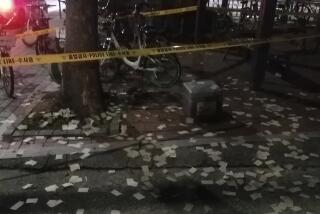Art or propaganda? Examining North Korean paintings in Austria
- Share via
Reporting from Vienna — More than 100 oils, watercolors, traditional Korean ink paintings and posters from the Korean Art Gallery in Pyongyang have been drawing a blurry line here between art and propaganda.
Does the show at Vienna’s MAK: Austrian Museum for Applied Arts/Contemporary Art offer a rare glimpse into an isolated and largely unknown North Korean art scene, or is it merely a stage for a regime that uses art not only as a messenger of its political ideology but also as a source of international funding?
The term “political propaganda” does indeed come to mind while viewing the exhibit “Flowers for Kim Il Sung,” on display since May and running through Sept. 5.
A significant portion of the show is dedicated to monumental portraits of Kim Il Sung and his son/successor, Kim Jong Il. They are either walking proudly together or are featured in scenes with peasants, soldiers or children in front of lush, blossoming gardens.
One work, titled “Kim Jong Il, the Supreme Commander of the KPA, Deeply Concerned Over the Soldiers’ Diet,” shows Kim looking into a cooking pot.
Another is a portrait of Kim Jong Il staring at paperwork on his desk, a cigarette burning in his hand. The night sky dominates the view from the window at his side. The canvas is called “The Endlessly Burning Light of the Party Center.”
All paintings with the Kims are carefully arranged in deep niches and protectively cordoned off with red rope. None of the artworks in the exhibit bears any comment about the nature of the North Korean regime — the main point contested by the critics of the show.
But MAK’s director, Peter Noever, appears unfazed by any debate surrounding the exhibit.
“I am neither a politician nor a political scientist. And besides, everybody knows what sort of a regime that is; we don’t have to explain this to anyone,” Noever said, sipping coffee in his office on the same floor as the North Korean artworks.
Such a display, the museum director said, offers a unique glimpse into the character, the mentality and the culture of a nation.
Along with portrayals of smiling, neatly dressed citizens, children with rosy cheeks under baby blue skies and happy peasants toiling amid stunning scenery, there are brightly colored prints in a style reminiscent of the Soviet poster tradition. The North Korean ones transmit messages — complete with exclamation marks — such as “Utmost efficiency in the use of electricity!”, “Spare every drop of water!” and “Even more consumer goods for the people!”
MAK officials said it is the first time the Korean Art Gallery has sent such a significant collection of work — dating from the 1960s to 2010 — abroad.
In North Korea, “art assumes a social function and is subordinate to the revolutionary process,” organizers of the Viennese exhibit said in a news release. North Korean artists are all members of state artist associations and have regular working hours. They receive a monthly salary for producing a certain number of works that “communicate the correct attitude, behaviors, morality and values.”
And their work has apparently become a profitable export that is able to skirt North Korea’s international isolation, helping to bring cash back home.
Ardent collectors can travel to the country to shop for art, said Rudiger Frank, professor of East Asian Economy and Society at the University of Vienna. Or works can be acquired at specialized galleries in more easily accessible locations, such as Beijing. Art can even be ordered directly from North Korean artists or the associations they work for.
Mansudae Overseas Project Group of Companies — the largest such association and the main center of production for North Korean art — was founded in 1959 and employs about 4,000 people, including about 1,000 artists working in all media.
Noever said his counterparts in Pyongyang had no financial demands for lending works to the Vienna exhibition, but arranging the show had its difficulties.
While on a trip to Japan seven years ago, he spontaneously decided to visit North Korea, managing to obtain a permit to enter alone and stay for a week. He went to the national art gallery in Pyongyang and met its manager, who showed him artworks that Noever decided had to be seen by a wider audience.
Persuading North Korean authorities, however, was not easy.
“They were surprised and did not understand at first why we would want such an exhibition,” Noever said. “It was a long back-and-forth affair. We had to wrestle with them because they had totally different, very academic ideas about what should go on display.”
He has had the chance to visit some of the artists’ workshops and said he was impressed by the decent working conditions, although he doubts that all North Korean artists have such good jobs.
After all his effort, Noever believes that bringing the North Korean artworks to Vienna was a coup. Frank too is convinced that having them in Austria is a good thing.
“One quickly forgets that North Korea is not only about nuclear weapons and its regime. The exhibition helps people think about what more is there; it brings up questions,” Frank said.
Damianova is a special correspondent.
More to Read
The biggest entertainment stories
Get our big stories about Hollywood, film, television, music, arts, culture and more right in your inbox as soon as they publish.
You may occasionally receive promotional content from the Los Angeles Times.










